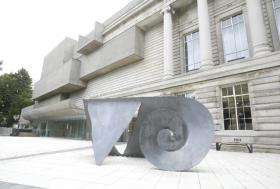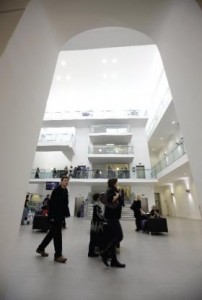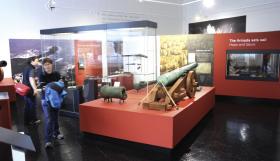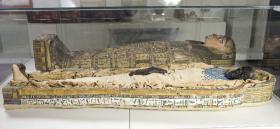Museum Eye
Published in 20th-century / Contemporary History, Issue 2 (March/April 2010), Reviews, Volume 18The Ulster Museum
Botanic Gardens, Belfast
www.nmni.com, +44 (0)28 90440000 [048 90440000 from RoI]
by Tony Canavan

The refurbished Ulster Museum—the façade has not changed much.
Two of Belfast’s iconic buildings recently reopened after being closed for refurbishment. The City Hall, once seen as a bastion of unionism, used the reopening to rebrand itself as the ‘people’s hall’ where all Belfast’s citizens would be represented. It seems to have succeeded in this. Belfast City Hall is a more welcoming place, where people can drop in to the new café or browse around one or other of the exhibitions housed there. I am told that the crowds arriving for the free tours mean that some people have to be turned away.
The other building is the Ulster Museum. I arrived on a cold, wet winter’s afternoon and found that, while the façade of the building had not changed much, the reception area shone out like a welcoming beacon. Once inside, I was surprised at the extent of the change. It is completely unrecognisable from the old museum. It is now an open-plan, brightly lit space with a shop on one side and a café on the other. There is a reception—sorry, ‘welcome’—desk where you can get details of the various exhibitions, alongside a staircase and lift to the other floors. A brochure about the museum may not actually tell you the opening hours but does guide you to the top ten things to see on a flying visit, what to do if you have only an hour to spend or if you have all day.

The new reception area shines out like a welcoming beacon.
The five floors are now called ‘zones’. The top two zones are the art exhibitions, the third one deals with nature, and the final two with history. I decided to limit myself to the history. This section begins with a gallery looking at the Ice Age and the earliest settlers of Ireland. Prehistory begins with the Mesolithic peoples and brings us up to the Bronze Age. All the new galleries are characterised by light and space. The exhibits are in glass cabinets and these are complemented by models, photographs and the now-ubiquitous audiovisual displays, some of which are interactive. Best of all are the touchable reproductions of some of the exhibits. In the prehistoric gallery these include stone tools, a replica of a tomb and animal fur.
The Bronze Age is well covered with artefacts of bronze, gold and clay as well as wood. It is in this gallery that a narrative of the history of Ireland, not just Ulster, begins, although there is a strange reluctance to identify the people. In this and the medieval gallery there is mention of Celtic art and the Gaelic language but not of Celts or Gaels. Pre-Viking Ireland is portrayed as a society of kings, warriors and scholars. The latter are linked with the saints who brought Christianity to the island.
It must be said, however, that the actual area devoted to the different eras is small, and if you are not careful you could walk from the early Irish through the Viking and Norman exhibits and be in the Nine Years’ War before you know it. A theme running through this area of the zone is the idea of two nations in Ireland and divisions within them—and that is even before the Reformation appears on the scene. The Nine Years’ War is set in the context of England’s struggle with the Spanish Empire. The Armada is covered but more could have been made of the treasures from the Girona, and I can see why people ask where all the old exhibits have gone.
With breathtaking speed, the rest of the history zone takes you from the Plantation to power-sharing. The major events and developments along the way have areas devoted to them, but here the narrative seems to get lost in an attempt to be neutral or perhaps inoffensive. The Plantation is covered in a small corner—strange, considering its huge importance. The Volunteers, the United Irishmen and the Orange Order are in an exhibition entitled ‘Spirit of Independence’, which also takes in 1798 and the Act of Union.

The Armada exhibition—well covered but more could have been made of the treasures from the Girona.
(All images: the Ulster Museum)
The rest of Irish history is also dealt with in a somewhat perfunctory fashion, in what seems like a hurry to get to the Troubles and the Good Friday Agreement. The area on the Troubles consists mainly of photographs and newsreel. It would be a futile exercise to comment on this particular exhibition. The museum itself acknowledges that this is recent history with conflicting interpretations of these years. The text on the panels and screens does its best to be neutral but the misspelling of Garret FitzGerald and reference to the ‘constitution of Éire’ would seem to indicate either shoddy research or insensitivity towards one community.
The history zone does include social history too, in the form of the development of industry and the growth of Belfast, and it must be said that there are other historical exhibits, like the Egyptian mummy, Takabuti, who gets a room all to herself, and other exhibitions like the ‘Window on Our World’.
The new Ulster Museum is certainly an improvement on the old in terms of design, layout and showing off the exhibits to best advantage. It is easy to get around and I noticed a good mix of people of all ages on my visit. Nevertheless, I also got the impression that there are fewer things out on display. This may be a result of the new layout or perhaps it is to allow the rotation of artefacts in the cabinets. In terms of how the history is presented, I suspect that it was too influenced by consultants and PR people. Spectacle is emphasised over substance. One important role of a museum must be to educate, and I am not sure that the new treatment of Irish history fully does that. HI

The Egyptian mummy, Takabuti, gets a room all to herself.
















